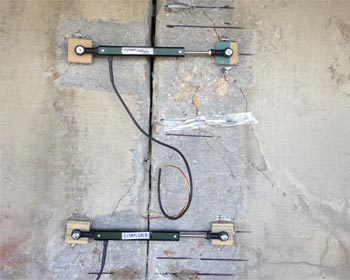Research Reports
Report Details
Abstract
 Bridge expansion joints are a particularly troublesome component of bridges and many departments of transportation (DOTs) are looking for a solution to deteriorating expansion joints on highway bridges. Bridge expansion joints create a break in the structural continuity of a bridge, allowing clogging gravels and corroding chlorides to enter. They are designed to absorb thermal movements of the bridge between two bridge elements. There are three main issues regarding expansion joints: maintenance, knowledge about thermal movements, and costs.
Bridge expansion joints are a particularly troublesome component of bridges and many departments of transportation (DOTs) are looking for a solution to deteriorating expansion joints on highway bridges. Bridge expansion joints create a break in the structural continuity of a bridge, allowing clogging gravels and corroding chlorides to enter. They are designed to absorb thermal movements of the bridge between two bridge elements. There are three main issues regarding expansion joints: maintenance, knowledge about thermal movements, and costs.
In order to prevent deterioration due to expansion joints, the joints must be cleaned regularly and replaced promptly after failure. However, most DOTs do not have the personnel, time, or resources to maintain their districts' expansion joints, which leads to bridge deterioration. Other similar maintenance and component issues have been addressed using a life-cycle cost analysis (LCCA). For this to be used on expansion joints the main issues of thermal knowledge, maintenance, and costs must first be addressed.
The main goals of this project are to 1) expand understanding of thermal loading effects on bridge expansion joints and 2) conduct an LCCA for joint elimination and retrofits for bridges in Colorado. These objectives were accomplished utilizing data from in-field instrumentation and finite element models. The study has been developed jointly between the Colorado Department of Transportation (CDOT) and researchers at Colorado State University.
Three main tasks were conducted to achieve the objectives: 1) collect and analyze long-term thermal loading data from existing bridges to assess thermal loading impacts on joints; 2) perform a parametric study using a calibrated finite element model to further understand joint behavior and retrofit options under thermal loads; 3) perform an LCCA for bridge expansion joint retrofitting, including impacts on bridge superstructure.
The significance of this work includes the results of data collection and analysis, the parametric studies, and the LCCA findings. The results of the numerical analysis show that clogged joints induce some localized stress, more so for the steel bridge, but do not significantly affect the global performance of the superstructure. The results also show that a reduction in moment demand on the superstructure is not apparent until a full-moment connection is utilized as a joint replacement. The parametric study and data analysis of thermal gradients indicate a stark need for further research into thermal gradients experienced by bridges. Finally, the LCCA concluded that a retrofit continuous bridge design would provide the most cost-effective design by decreasing joint replacement costs and pier cap corrosion. The modeling approach outlined in this study and the LCCA framework can be applied to any bridge and be used by CDOT to determine the viability of joint elimination for any bridge in Colorado.
How to Cite
Mahmoud, Hussam, Rebecca Atadero, Karly Rager, Aura Lee Harper-Smith, and Mehrdad Memari. Effect of Service Temperature on Joint Removal in Steel Bridges, MPC-18-366. North Dakota State University - Upper Great Plains Transportation Institute, Fargo: Mountain-Plains Consortium, 2018.